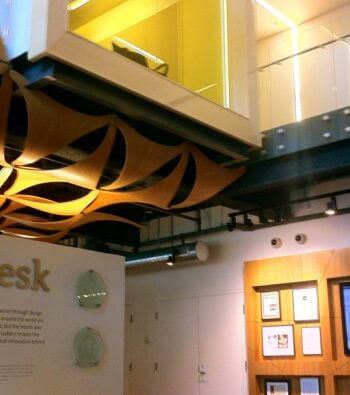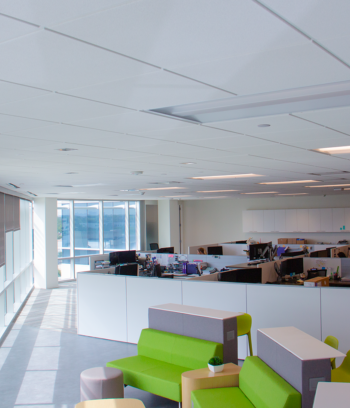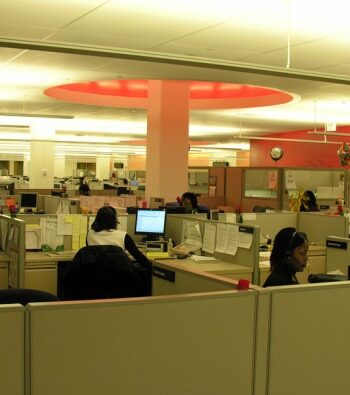Challenge
Designing a space for the architecture software leader
Autodesk, Inc., is the industry leader for 3D design and engineering software for architecture engineering, construction, manufacturing and media entertainment applications. Customers across the globe use Autodesk software to design, visualize and simulate their ideas before they come to fruition. When the team was designing the new headquarters for the Architecture, Engineering and Construction Division, they needed to build a facility that met the needs of the division while representing the company’s history of innovation and commitment to collaborative and creative design.
The new headquarters features a three-story lobby with large windows, a two-story wooden artistic divider and exposed ventilation and beams. The open layout office areas feature high, open ceilings, exposed ventilation and steel beams, short glass workstation barriers and large windows. Adjacent to the cubicles are a variety of conference rooms and private offices with frosted glass walls and smooth concrete flooring. The environment is designed to encourage team collaboration and effective information sharing.
Acoustical challenges and increasing privacy in a collaborative space
As Autodesk was designing their new headquarters, the team anticipated early in the process that the architectural design would pose acoustical issues. The space, as designed, features numerous reflective surfaces such as glass, concrete, metal and wood. Additionally, while the short-style of the cubicle partitions is aesthetically pleasing, they do not block sound from traveling throughout the open office layout.
The design team focused on enabling employees to move into the new space and feel comfortable so they could be immediately productive. The goals included ensuring that employees would not be distracted by noise or others’ conversations and that conference rooms provided the appropriate level of privacy.
A greener AutodeskAnother challenge for the design team was to ensure the new headquarters was LEED certified. The goal was to certify the core and shell of the facility as well as the interior space. Autodesk needed a solution for their internal acoustical challenges that was energy efficient and able to contribute to their LEED score.
Solution
Sound masking was recommended during the design process to address noise created by the many hard reflective surfaces that were a critical part of the aesthetic design. Autodesk needed their solution to be simple to manage, flexible to work within their open ceiling environment and able to be customized for their unique space. Qt sound masking system proved to be the most adept at solving Autodesk’s challenges.
Each floor of the headquarters is equipped with a Qt 600 control module. The Qt 600 gave Autodesk the ability to separate each floor into six distinct zones, allowing for appropriate audio levels in each space. In the open office areas as well as the three-story lobby, the Qt emitters were installed onto the exposed beams. Qt emitters were mounted directly into drywall or acoustic tile in the main corridors and areas surrounding the conference rooms. Each of the eighteen zones has a different decibel level requirement. After occupancy, the levels were determined for maximum effectiveness.
Result
Unobtrusive is an understatement
Once the facility was completed, the employees entered their new space unaware that sound masking was deployed in the space. After three months of use, the facilities managers decided to see if the employees would notice if the system was turned off. Upon turning the system off, the facilities staff immediately received a number of complaints regarding noise distractions.
Platinum is the new green
Autodesk’s new headquarters received a Gold rating for LEED Core and Shell Development and the coveted Platinum rating for LEED Commercial Interior. While several factors contribute to LEED Commercial Interior certification, the Qt Quiet Technology system helped Autodesk achieve the perfect platinum rating, because of its energy efficiency and its ability to exceed industry standards. The Qt 600 uses less than 24 watts of power to provide masking coverage of up to 72,000 square feet. The LEED Commercial Interiors Certification is independent from the building’s LEED score and is based on providing an environment that is comfortable, distraction-free and ensures a level of employee privacy.
Intelligent design meets simple operation
Additionally, the Facilities Coordinator, Steve Boulas, appreciates the system’s set-it-and-forget-it ease of use. “The software is easy to use and allows me to modify any zone without needing to leave my office.” Steve adds, “But I really don’t have to make adjustments, the system just works.”
In all, the addition of the Qt Quiet Technology system has led to a better aesthetic design, while ensuring a distraction-free environment with privacy for each employee.
About Biamp
Biamp® is a leading provider of innovative, networked media systems that power the world’s most sophisticated audiovisual installations. The company is recognized worldwide for delivering high-quality products and backing each one with a commitment to exceptional customer service.
Recipient of the Frost & Sullivan 2018 Global Installed Audio Conferencing Enabling Technology Leadership Award, Biamp is dedicated to creating products that drive the evolution of communication through sight and sound. The award-winning Biamp product suite includes: Tesira® media system for digital audio and video networking, Devio® collaboration tool for modern workplaces, Audia® digital audio platform, Nexia® digital signal processors, Vocia® networked public address and voice evacuation system, Cambridge® sound masking solutions, and loudspeakers for installed sound applications from Community Loudspeakers® and Apart Audio®. Each has its own specific feature set that can be customized and integrated in a wide range of applications, including corporate boardrooms, conference centers, huddle rooms, open floor environments, performing arts venues, courtrooms, hospitals, transportation hubs, campuses, retail, hospitality, military and government, and multi-building facilities.
Founded in 1976, Biamp is headquartered in Beaverton, Oregon, USA, with additional offices around the globe. For more information on Biamp, please visit www.biamp.com.




